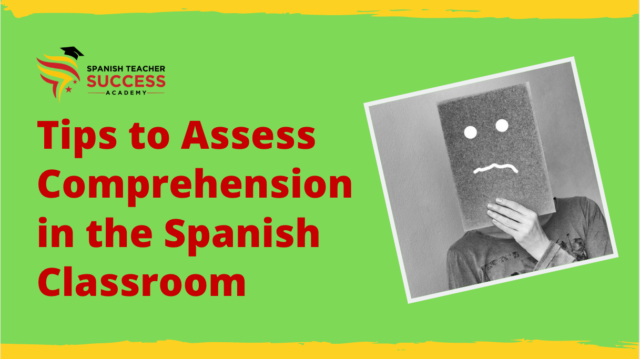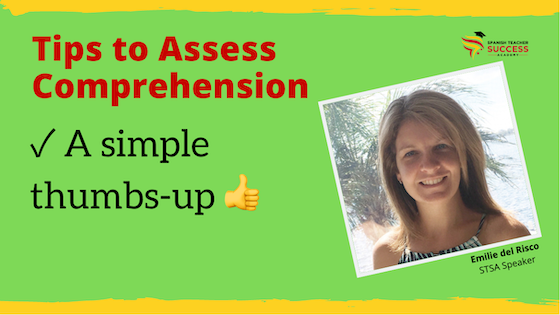
In summary, language comprehension is “understanding what other people say and write”. Spanish teachers (and any world language teacher) must make sure that their students are actually understanding. But, how do you know? How do Spanish teachers access comprehension every day?
Here’s what speakers from the Spanish Teacher Success Academy online conference do…
Sam Finneseth
“Teach to the eyes. When kids are confused, you know.”
Sam relies on her observation skills to determine if students are understanding her lesson. As well, Sam uses sticky notes and group activities to communicate with her students; students can write responses on the sticky notes and also respond to each other to demonstrate their understanding of the language.

Allison Wienhold
“I assess comprehension all the time.”
For Allison, assessing comprehension frequently works best. Both verbal and non-verbal cues work for her and her students. Simple yes or no questions are effective as well as exit tickets and informal check-ins.
Formal assessments are important for novice students who are just getting started with reading comprehension; providing English questions in English and asking for a response in Spanish is useful.

Bethanie Drew
“In a variety of ways…I think there are multiple ways of addressing that, depending on what you’re going for.”
For lower levels, Bethanie usually incorporates a visual element into her assessments, either a photograph or a picture; also, she allows students to respond to questions in English. Because upper level students in Bethanie’s AP class need to be prepared for the AP exam, which is in Spanish, she assesses them in Spanish only.

Emilie del Risco
“Through a variety of ways!”
Anything from a simple thumbs-up to take-aways jotted down on a sticky note work for Emilie as long as she feels she understands where her students are and what they need from future lessons.

Laurie Clarcq
“Language, used in communication, is putting a picture in the heart and/or the mind of another person so we frequently talk about ‘what does your picture look like?’ so we can compare [their] picture with my picture.”
Laurie likes to focus on the details of these mental pictures in order to make the communications between two people as accurate as possible. She incorporates drawing tasks into her comprehension exercises, a process that, in her experience, prevents students from thinking in English.

Meredith White
“Assessing comprehension is hard…it helps to decide what our goals are.”
Meredith prefers a flexible approach to assessment. Sometimes, she uses open-ended rubrics, while other times, she uses less formal approaches to finding out what her students know and understand. A variety of methods is important, in her opinion, especially because she has found that listening comprehension exercises sometimes test hearing more than listening. Meredith’s work in large classrooms has taught her that it is usually best to meet students where they are for useful results.

Jen López
“In a lot of ways!”
Jen teaches heritage students, so when assessing comprehension, she is less concerned with their overall listening comprehension of Spanish, which is usually good, and more concerned with their ability to absorb various skills they have learned in class. Jen employs questioning techniques, relying on her relationships with her students to determine in informal ways how they are progressing.

Erin Gilreath Carlson
“The looks in their eyes–sometimes, you can just see it in their eyes.”
Erin prefers to incorporate a variety of approaches to assessment. She employs both informal and formal methods of assessment, ranging from casual observation to random questioning to IPAs.

Albert Fernández
“I assess comprehension through day-to-day visual checks.”
Albert can see when his students are learning, which means he can also observe when they are puzzled. Asking direct questions about their understanding is also useful to him. Albert also asks students to write summaries, in both English and Spanish, a process that can be revealing. Albert often offers students the option to write in either language, depending on the assessment.

Kristin Montgomery
“I like to go around and listen to the students’ conversations.”
Kristin teaches upper level classes, and she is able to hear the levels at which students are understanding their lessons through their group conversations. As well, she likes to use exit slips to check in with students and more focused assessments.

Jeremy Jordan
“Sometimes, they think they know more than they do, which is a little tricky.”
Jeremy looks closely at his students’ non-verbal body language to determine how well they are comprehending him. He also asks his students to demonstrate comprehension in other ways, with quizzes, for example, and to ask students to self-assess their understanding. Jeremy notes that sometimes, students claim more understanding than they actually have, so he looks for trends in the quiz results to determine if understanding is truly established.

Michaela McCoughey
“Sometimes, it doesn’t matter to me what language they answer the question in, because I’m looking to see if they understand the question.”
Michaela asks her Spanish I and II students carefully-crafted questions, and she uses cognates whenever she can in order to assess their reading comprehension. She offers students support while they are taking an assessment, answering whatever questions she can, and through this process, Michaela is able to assess comprehension.

Jodi Stokdyk
“I’ll differentiate according to the difficulty of the listening [exercise], or the difficulty of the reading.”
Jodi follows a tiered breakdown of skills that is endorsed by ACTFL, selecting specific details from her lessons to assess and asking her students to demonstrate their own preference for these kinds of specific details that highlight their understanding.

Tina Hargaden
“I feel like pretty much every moment of class time, I am assessing their comprehension in that moment.”
Tina points out that this question about comprehension is relevant for all teachers, not just language teachers. Every single teacher should be focusing on comprehension and ensuring that their students are understanding them.
She recommends that every teacher take silent breaths between every chunk of language spoken to students, to look around to check for understanding and to slow down in a general sense so all students can follow their lessons. As well, checking for comprehension at the end of a day’s lesson with a quick quiz or a series of questions about the content of the day. Even yes or no questions will work here.

Learn more about the Spanish Teacher Success Academy online professional development sessions that bring together 25 world-class experts who will share with you the best strategies for teaching Spanish. 